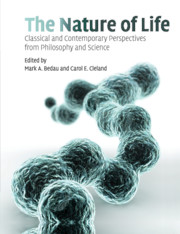Book contents
- Frontmatter
- Contents
- Preface
- Acknowledgments
- Sources
- About the authors
- Introduction
- SECTION I CLASSICAL DISCUSSIONS OF LIFE
- SECTION II THE ORIGIN AND EXTENT OF NATURAL LIFE
- SECTION III ARTIFICIAL LIFE AND SYNTHETIC BIOLOGY
- 16 Learning from functionalism: prospects for strong artificial life
- 17 Life, “artificial life,” and scientific explanation
- 18 Alien life: how would we know?
- 19 Automatic design and manufacture of robotic life forms
- 20 A giant step towards artificial life?
- 21 Approaches to semi-synthetic minimal cells: a review
- 22 Creating “real life”
- SECTION IV DEFINING AND EXPLAINING LIFE
- Supplementary bibliography on life
- Index
- References
22 - Creating “real life”
Published online by Cambridge University Press: 10 November 2010
- Frontmatter
- Contents
- Preface
- Acknowledgments
- Sources
- About the authors
- Introduction
- SECTION I CLASSICAL DISCUSSIONS OF LIFE
- SECTION II THE ORIGIN AND EXTENT OF NATURAL LIFE
- SECTION III ARTIFICIAL LIFE AND SYNTHETIC BIOLOGY
- 16 Learning from functionalism: prospects for strong artificial life
- 17 Life, “artificial life,” and scientific explanation
- 18 Alien life: how would we know?
- 19 Automatic design and manufacture of robotic life forms
- 20 A giant step towards artificial life?
- 21 Approaches to semi-synthetic minimal cells: a review
- 22 Creating “real life”
- SECTION IV DEFINING AND EXPLAINING LIFE
- Supplementary bibliography on life
- Index
- References
Summary
In its modern incarnation, use of the term artificial life was at first confined mainly to the world of computer simulations. But when Langton expressed the hope of building models so lifelike that they would be actual examples of life, he deliberately—and provocatively—left open the possibility of constructing these examples in some other (nonvirtual) medium. Indeed, the very ambition to identify “the essence of life” was from the start—for Langton and his colleagues, just as for their precursors in the early part of the last century—linked to the vision of transcending the gap between the living and the non-living. The hope was to create artificial life, not just in cyberspace but in the real world. Rodney Brooks's contribution to the web-based “World Question Center” makes the link explicit: “What is the mathematical essence that distinguishes living from non-living,” he asks, “so that we can engineer a transcendence across the current boundaries?” It is hardly surprising, therefore, that artificial life quickly became the operative term referring indiscriminately to digital organisms and to physically embodied robots inhabiting the same four-dimensional world as biological organisms.
In a recent book entitled Creation: Life and How to Make It, Steve Grand writes, “Research into artificial life is inspiring a new engineering discipline whose aim is to put life back into technology. Using A-life as an approach to artificial intelligence, we are beginning to put souls into previously lifeless machines … The third great age of technology is about to start.
- Type
- Chapter
- Information
- The Nature of LifeClassical and Contemporary Perspectives from Philosophy and Science, pp. 289 - 294Publisher: Cambridge University PressPrint publication year: 2010



